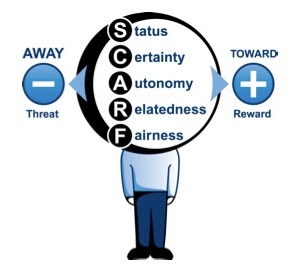The SCARF that Ties (part 2)
(click below to view the video or read on if you’d prefer!)
Hello and welcome to the last edition of Career Tips for 2014! In this offering, let’s continue unpacking the simple yet powerful model to make sense of your life at work which we started to  look at last month.
look at last month.
You may recall the model is called SCARF and it is anchored within the basic principle that our brain’s purpose is to protect us: our brain continually seeks to identify potential threats. This negative bias is at the root of our survival. When the coast is clear, our brain then seeks to optimise our sense of comfort and wellbeing.
You see in the graphic depiction above that SCARF is an acronym for the five words of Status, Certainty, Autonomy, Relatedness and Fairness. Last month, we looked at the two dimensions of Certainty and Autonomy.
If you missed last month’s offering, you can catch it up here.
Whereas the domains of Certainty and Autonomy assess how we feel about any experience from the point of the self – the inner dimension of human experience – Status, Relatedness and Fairness assess how we feel about any experience from the point of view of our place in the environment in which the experience occurred: it is the external dimension of human experience.
Let’s start with Relatedness. Quite simply, Relatedness is about whether you belong, whether the other person or persons is/are friend or foe. People naturally form ‘tribes’ where they experience a sense of belonging. The concept of being inside or outside the group is probably a by-product of living in small communities for millions of years, where strangers were likely to be trouble and should be avoided. We all know that feeling of arriving at a party and your friends are not there yet: you feel uncomfortable until you strike a conversation with someone and finally feel like you belong. In the office, it’s that experience of walking into a meeting and feeling out of place. In a workplace context, it is also about how integrated you are within your team.
sense of belonging. The concept of being inside or outside the group is probably a by-product of living in small communities for millions of years, where strangers were likely to be trouble and should be avoided. We all know that feeling of arriving at a party and your friends are not there yet: you feel uncomfortable until you strike a conversation with someone and finally feel like you belong. In the office, it’s that experience of walking into a meeting and feeling out of place. In a workplace context, it is also about how integrated you are within your team.
We perceive people who are different to us as foes and this explains why diversity is so hard to practice. As we get to know these people, we discover affinities and our brain may come to view this individual as ‘friend’: when you feel uncomfortable with someone, resist the temptation to avoid them but rather engage with them into small talk to see if you share any common point. When you discover a shared interest, you will notice yourself relaxing markedly. If small talk is hard, then engage around a shared professional goal: making an ally will also assuage your Relatedness threat.
Whereas Relatedness is about belonging, Status is about relative importance, ‘pecking order’ and seniority. Anytime we are with another or others, we have an unconscious sense of our relative status, our ranking in the group: are you at the top or nearer the bottom of the pecking order? In a workplace context, your status goes beyond your job description and formal role but how you manifest your remit. For instance, the boss’s PA may have great Status because of her capacity to control access to the chief. Achieving and applying new learning also contribute to ‘good’ status.
 In the office, our status takes hits when we are less than effective at a task, whether it’s an outside (our manager?) who points this out or just our own perception of how well we did. Someone giving us advice in a way we receive as condescending in another manifestation of a hit to our status. And have you noticed how some meetings go round in circles because some people around the table all want to have the last word? That’s status egging them on, the unconscious fear of appearing ‘less’.
In the office, our status takes hits when we are less than effective at a task, whether it’s an outside (our manager?) who points this out or just our own perception of how well we did. Someone giving us advice in a way we receive as condescending in another manifestation of a hit to our status. And have you noticed how some meetings go round in circles because some people around the table all want to have the last word? That’s status egging them on, the unconscious fear of appearing ‘less’.
To soothe your status when it is feeling threatened, focus on achieving. Impress by delivering something which showcases your talent: recognition is a great boost to Status. Clearly promotion and financial reward also rub Status the right way. Third is learning, expanding your capabilities and having folks notice your improvement. Finally, connecting to your competencies – for example when you update your CV – will also enhance your self-worth and therefore your sense of Status.
Last but not least: Fairness. Isn’t it interesting that a sense of fairness is deep-rooted in our brain? Brain imagery studies have showed that receiving 50 cents generated more of a sense of pleasure than receiving $10, when it was 50 cents out of a dollar, and the $10 was out of $50. The need for fairness may be part of the explanation as to why people experience pleasure when doing volunteer work to improve their community: it is a sense of decreasing the unfairness in the world. Unfair situations drive some people to sacrifice themselves in order to right perceived injustices – think of the struggle against apartheid or the Civil Rights movement in the US. When we perceive some people as unfair, we no longer sympathise with them and in fact feel pleasure when they suffer – that ‘s the root of the concept of ‘schadenfreude‘, rejoicing at another’s pain.
people as unfair, we no longer sympathise with them and in fact feel pleasure when they suffer – that ‘s the root of the concept of ‘schadenfreude‘, rejoicing at another’s pain.
In a workplace context, Fairness is often threatened: for instance, when we are allocated a task which does not play to our strengths, when we are compensated less than our colleagues, when redundancies don’t hit all the teams equally, when there appears to be double standards affecting various groups as well as, importantly, when practiced values are at odds with the firm’s official corporate values. It may be hard to remedy a threat to Fairness as it may be outside your control to redress the imbalance. What is likely to help is transparency: for instance, engage your manager around your capabilities to ensure that they more adequately appreciate your talent and therefore, next time around, give you task which leverages your abilities.
There you have it: a look at what can make you feel excluded, disengaged, under-appreciated, demotivated (and I could go on) in the office because your need for Relatedness, Status or Fairness has been threatened. Sadly, a negative development in the office can trigger a threat across several of the SCARF domains, leaving feeling very despondent. I am hopeful that SCARF will help you read your negative reactions to workplace challenges and then strategise for greater enjoyment.
Does this sound like it might be helpful? As usual, I’d love to hear from you so please do feel free to comment about this article in the box below. Similarly, if you have any question or comment or want to discuss your personal circumstances, you are welcome to email me by clicking here.
If this article resonated with you, don’t hesitate to contact me for a chat where we would explore what is going on for you and what you would like to have happen. To contact me, click here.
If you don’t have it already, get your copy of “5 Gear Shifts to Accelerate your Career!” and learn about the five building blocks of any successful career! Get it here now!










